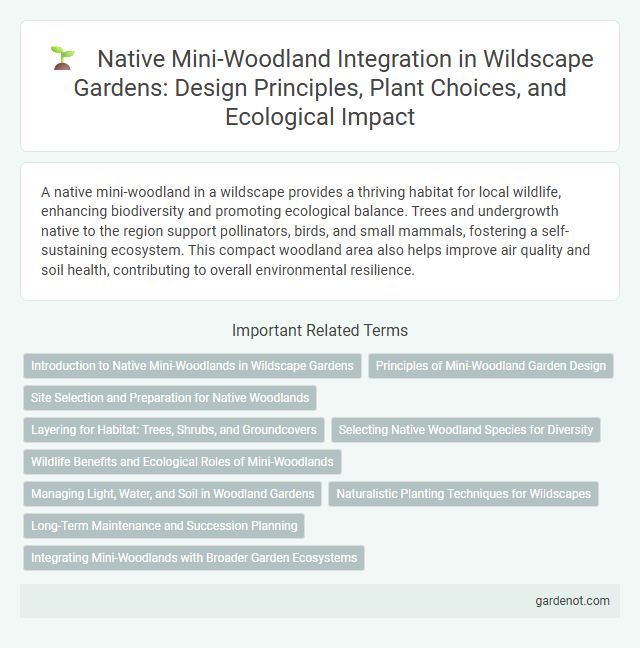A native mini-woodland in a wildscape provides a thriving habitat for local wildlife, enhancing biodiversity and promoting ecological balance. Trees and undergrowth native to the region support pollinators, birds, and small mammals, fostering a self-sustaining ecosystem. This compact woodland area also helps improve air quality and soil health, contributing to overall environmental resilience.
Introduction to Native Mini-Woodlands in Wildscape Gardens
Native mini-woodlands in Wildscape Gardens create compact, biodiverse habitats featuring indigenous tree species such as oak, hawthorn, and birch. These small-scale woodlands support native wildlife by providing shelter and food sources while enhancing soil health and local ecosystem resilience. Incorporating native plants ensures compatibility with regional climate and promotes natural regeneration and biodiversity within urban and rural garden settings.
Principles of Mini-Woodland Garden Design
Mini-woodland garden design prioritizes native plant species to create a sustainable, biodiverse habitat that supports local wildlife. Key principles include layering vegetation with groundcovers, shrubs, and canopy trees to mimic natural forest structures while optimizing space. Emphasizing soil health, seasonal variation, and native fauna attraction ensures a thriving mini-woodland ecosystem within limited garden areas.
Site Selection and Preparation for Native Woodlands
Selecting a site for a native mini-woodland requires assessing soil quality, sunlight exposure, and existing vegetation to ensure optimal growth conditions for indigenous species. Preparing the site involves removing invasive plants, improving soil health through organic amendments, and planning for natural regeneration or targeted planting of native trees and understorey flora. Proper site preparation fosters biodiversity, supports local wildlife habitats, and enhances the ecosystem services provided by native woodlands.
Layering for Habitat: Trees, Shrubs, and Groundcovers
Native mini-woodlands create rich habitats through strategic layering of trees, shrubs, and groundcovers, enhancing biodiversity and ecological balance. Mature oaks and maples form the canopy, while understory shrubs like hazel and dogwood provide shelter and food for wildlife. Groundcovers such as ferns and native grasses support soil health, moisture retention, and offer critical habitat for insects and small mammals.
Selecting Native Woodland Species for Diversity
Selecting native mini-woodland species enhances biodiversity by prioritizing indigenous trees such as oak, birch, and hazel, which support local wildlife and ecosystem resilience. Incorporating a mix of native shrubs like hawthorn and blackthorn creates layered habitats essential for birds, insects, and mammals. This diversity promotes soil health, natural pest control, and a balanced microclimate within the mini-woodland environment.
Wildlife Benefits and Ecological Roles of Mini-Woodlands
Native mini-woodlands provide critical habitats for diverse wildlife species, supporting pollinators, birds, and small mammals by offering food, shelter, and breeding sites. These compact ecosystems enhance biodiversity, promote natural pest control, and improve soil health through nutrient cycling and organic matter decomposition. Their ecological roles also include carbon sequestration and maintaining local hydrological cycles, contributing to climate resilience and environmental stability.
Managing Light, Water, and Soil in Woodland Gardens
Managing light in native mini-woodlands involves strategic canopy layering to ensure understory plants receive adequate sunlight for photosynthesis. Proper water management includes installing rain gardens or mulching heavily to maintain moisture levels, essential for native species thriving in woodland ecosystems. Soil health is preserved through organic matter enrichment and avoiding compaction, fostering nutrient availability and microbial diversity critical for sustainable woodland growth.
Naturalistic Planting Techniques for Wildscapes
Native mini-woodlands in wildscapes utilize naturalistic planting techniques that emphasize species diversity and ecological balance, fostering habitats for local wildlife. Planting native trees, shrubs, and groundcovers in clustered formations replicates natural forest structures, enhancing soil health and promoting biodiversity. These techniques support pollinators, improve carbon sequestration, and create resilient ecosystems suited to regional climate conditions.
Long-Term Maintenance and Succession Planning
Long-term maintenance of native mini-woodlands involves regular monitoring of species health, controlling invasive plants, and managing soil quality to ensure ecosystem stability. Succession planning prioritizes planting native pioneer species followed by shade-tolerant trees to mimic natural woodland development over decades. Integrating adaptive management strategies supports biodiversity resilience and promotes sustainable habitat growth within the Wildscape environment.
Integrating Mini-Woodlands with Broader Garden Ecosystems
Integrating native mini-woodlands into broader garden ecosystems enhances biodiversity by providing essential habitats for local wildlife and supporting pollinator populations. These compact woodlands contribute to soil health through natural leaf litter decomposition and promote microclimate regulation, benefiting surrounding plants. Designing with native tree species ensures resilience and ecological harmony within garden landscapes, fostering sustainable urban green spaces.
Native mini-woodland Infographic

 gardenot.com
gardenot.com